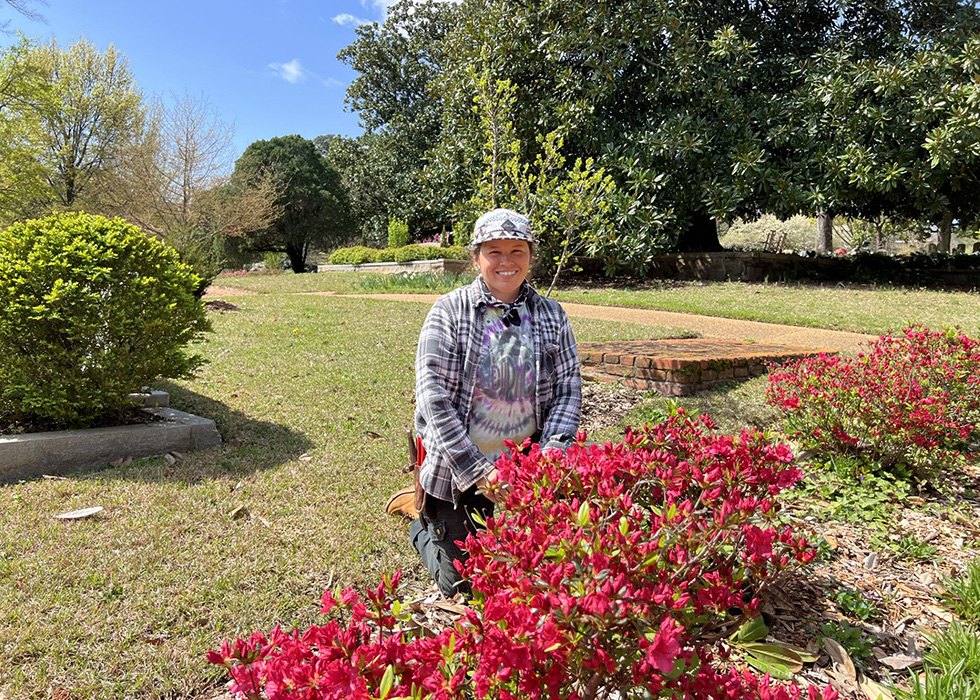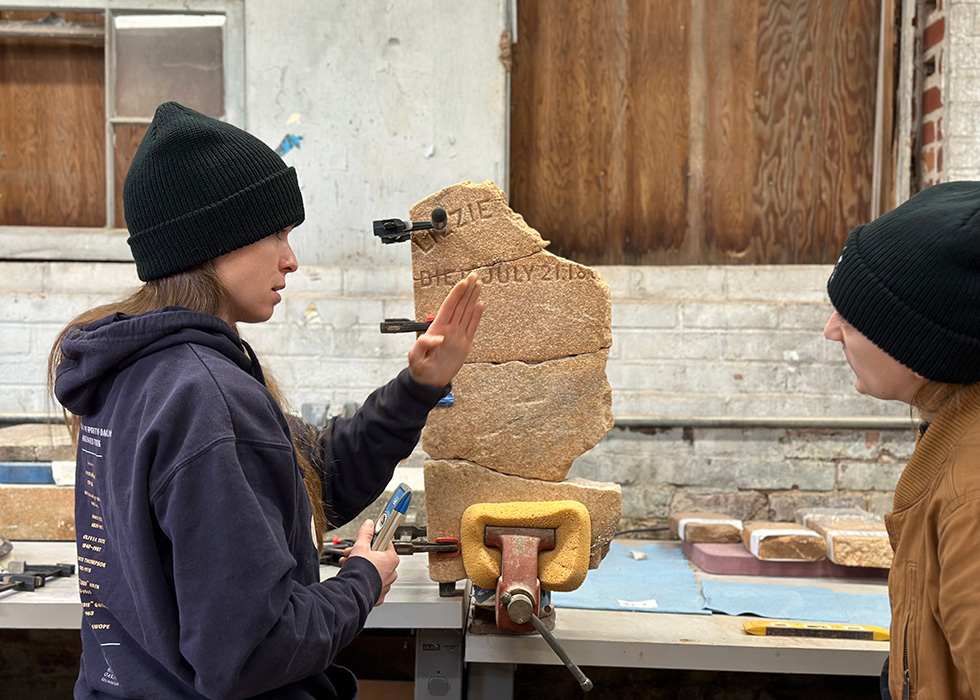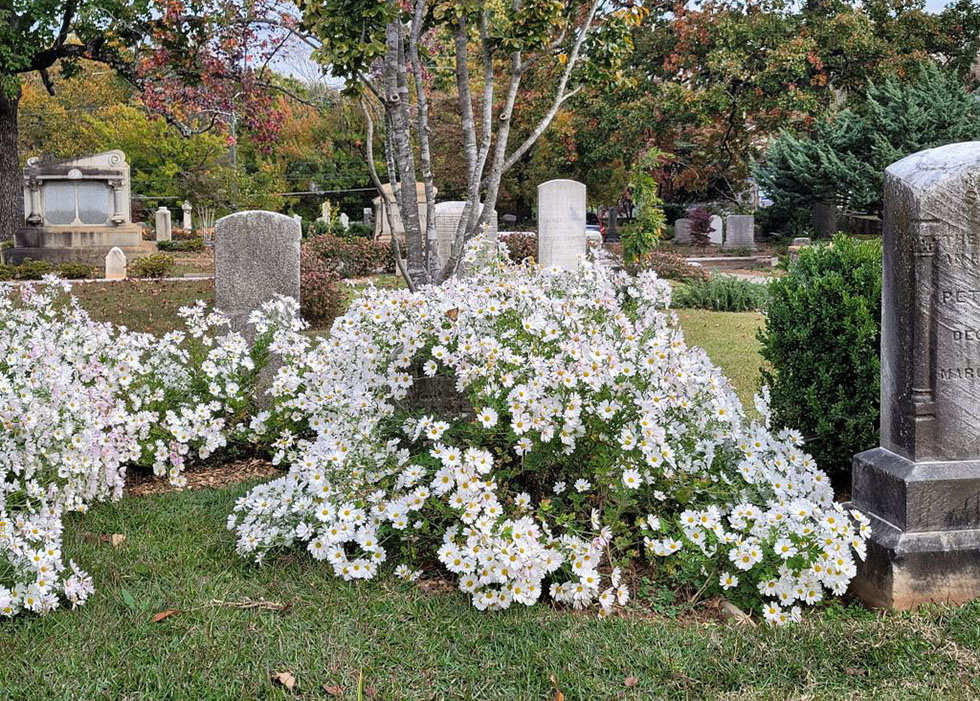
Illuminating Oakland’s Early Landscapes: The Greenhouses
During Illumine we are showcasing just a few of the interesting stories our creative team is shining a light on during this four-day light experience.
The early 1870s were the dawn of a new golden era for the “City Grave Yard.” A new cemetery design and a new ethos of landscape gardening brought by the newly-elected Sexton, John Connally, fostered a sense of pride among Oakland’s families. Much of the “new” land purchased in 1866 and 1867 for the expanded cemetery was fields of grass and weeds. Taming open fields into manicured landscapes requires ornamental plants and shrubs (and lots of them) and a gardener with the vision to help guide families and direct cemetery staff.
A First Greenhouse and a Second
After Sexton Connally got the first order of business underway with “opening” the new land – namely “cutting” new roads and pathways – he turned his attention to the finer points of beautification. In 1872 he lobbied for and had constructed a pit or greenhouse, at the cost of $251.45. Apparently, this pit house was intended solely for his efforts to beautify the cemetery. What plants Connally had grown and protected, and where they were planted on the grounds, is left to conjecture.
In less than a year, as the specter of frost drew nigh on the calendar of 1873, the ladies of Oakland’s families wished to make use of the new city facilities for their own cold-sensitive cemetery plants. The City was none too pleased with sharing a municipal resource with private citizens. The matter was of such importance it required the City Council’s Committee on Cemetery to issue a new rule that September, “instructing the city sexton to first take care of the plants, flowers, etc., and if there is room in the greenhouse to allow citizens to deposit there, provided they pay for the same.” According to The Constitution, the second greenhouse was three times as large as first and heated by a furnace, while the original hothouse was heated by a stove. Both houses were full by the end of October, a sure sign of the ladies’ horticultural efforts.
Sexton Connally’s successor continued the gardening tradition at Oakland. Evidently a prudent manager as well, Sexton L. Greene Holland obliged his lady-gardeners the next year with a second greenhouse, inferred from the cemetery’s annual report:
“The two green houses have been connected thereby affording ample room to preserve the flowers from the cold blasts of Winter, that the friends of those that lie within the enclosure of Oakland Cemetery array to see proper to deposit therein and when Spring presents her smiling face can be transplanted on the graves for their loved ones, seemingly as fresh and well preserved as if the rugged blasts of Winter had never have blown.”
Since the Civil War Atlanta had numerous nurserymen and florists with greenhouses, selling tender plants and height-of-fashion tropicals such as palms, calla lilies, begonias, fuschias, pelargoniums, apple geraniums, calceolarias, caladiums, and cold-tender ferns. Camellias, considered cold-tender, were a very popular greenhouse plant from the early 1870s to the 1890s. White camellias especially were regularly remarked upon in The Constitution’s society page.
Growing Bananas?

Two images offer clues as to what the ladies overwintered. An 1894 photograph of Mamie O’Keefe’s burial, north of the Sexton’s office, shows two exotic plants paired in urns flanking the steps into the lot. Three other urns appear to be planted with either large flowering plants such as geraniums or shrubs similar to hydrangeas. A circa 1907 postcard shows two large banana trees in the corner of the lot, located on the eastern edge of South Public Grounds. Given the mature size of the bananas, it seems they spent a number of winters in the Oakland greenhouse.
Through the 1880s and 1890s, gardening expanded at Oakland, and there was money to be made, so reasoned the unscrupulous Sexton T.A. Clayton. Among the offenses detailed in the 1896 investigative report made to the City Council supporting Clayton’s termination was his abuse of the greenhouse:
“I find that Mr. Clayton has used the hothouse that the city built and paid for – for the use of lot owners to place their flowers in winter time – for his own use – raising flowers and selling them – and that the city paid all the expenses of same, including the salary of a florist…” While very illegal, likely the greenhouse was very lovely indeed, being under the care of a professional florist.
Fighting for Space
 By 1899 even with Sexton Clayton’s illegal flower operation terminated, the demand for space was exceeding the greenhouse capacity, convincing the City a new structure was in order. The Committee on Cemetery was quite pleased with its solution, “Finding our greenhouse too small, we have sold the lot on which the old one stood for $600, and have built a larger one costing only $400.” This structure’s ruins stand today.
By 1899 even with Sexton Clayton’s illegal flower operation terminated, the demand for space was exceeding the greenhouse capacity, convincing the City a new structure was in order. The Committee on Cemetery was quite pleased with its solution, “Finding our greenhouse too small, we have sold the lot on which the old one stood for $600, and have built a larger one costing only $400.” This structure’s ruins stand today.
The new, larger greenhouse caused great consternation in some quarters of the local florist community. Central Nursery – which became Lambert Floral Company when the nursery passed to the younger generation – had sold cut flowers, funeral arrangements, shrubs, plants, and flowers to Oakland’s families and sextons since 1870.
Located across Fair Street (present-day Memorial Drive, specifically where Tin Lizzy’s now stands) the family-owned business had a close knowledge of Oakland’s doings. So when the new greenhouse space became available, John Lambert petitioned the City Council in November 1899 for tax relief due to loss of income, claiming: “the keepers of the cemetery were accepting flowers and plants from private residences and placing them in the greenhouse, there for the winter free of charge.” The Constitution reported Sexton Barefield’s testimony in the cemetery’s defense, that “no flowers or plants other than those from the graves in the cemetery were in the greenhouse.” As there were no rules in place addressing the management of the greenhouse, one was drafted for Council to act upon (to the satisfaction of Mr. Lambert) forbidding “the placing of flowers in the greenhouse other than those from the graves in the cemetery.”
The cemetery staff quickly put the new greenhouse to use. Receipt books from 1902 to 1910 document regular annual purchases of hundreds of small flower pots from Southern Terra Cotta Works or from H.G. Hastings. For the spring of 1902, the cemetery purchased from McMillan Seed Store three dozen hyacinth bulbs (sold by color) and nasturtium seeds. For the spring of 1903, it purchased 70 flower bulbs from H.G. Hastings and 70 flower pots from Southern Terra Cotta Works. That same spring the cemetery purchased an additional 1,500 two-inch pots and 500 three-inch pots, presumably to start summer plants for the grounds from seed.
While the cemetery crew potted bulbs and started annual flower seeds in the greenhouse, the ladies of Oakland’s families continued to rely on the greenhouse for overwintering their tender plants. Even with the additional space, demand exceeded supply. For within five years, by 1904 City Council was forced to pass an ordinance regulating space allocation in the greenhouse. Individuals were allowed the space equivalent to 12 eight-inch flower pots. These larger pot sizes would fit quite nicely into an urn, a popular Victorian garden ornament and widely used at Oakland. Period photographs indicate some families had numerous urns on their lots, often not attached to other stonework. Thus, while urns survive on the grounds today, and the remains of others mounted to stonework exist, many free-standing urns disappeared without a trace.
Oakland’s gardening and greenhouse operations were robust by the mid-1910s. By 1913 a florist on the cemetery’s payroll supported the greenhouse. In the fall of the same year, an article in The Constitution reported the superintendent appeared before the City’s Finance Committee to plead for appropriations to repair the greenhouse, as otherwise, it would be “useless this winter in protecting the thousands of dollars’ worth of plants and shrubbery.”
Superintendent Porter’s plea was successful, as in 1914 the City paid for improvements to the greenhouse. In the year’s annual report to the City Council, the Cemetery Committee reported, “We have installed Cement Beds in the Green House, put in new Flue about 100 feet long, built an addition of 12 x 55 feet on the North side of the Green House, put on a new roof and painted the house inside and out, at a cost of $543.76.” The extent of the florist’s responsibilities can be inferred from the order of 300 plant labels in 1915.
Disrepair…And a Donation

Later in the 20th century, Oakland’s greenhouse was pressed into service, supporting gardening efforts in public parks across Atlanta. It finally fell into disrepair and was dismantled by the 1970s, although its brick shell continued as a center of Historic Oakland Foundation’s gardening efforts. With the Buckhead Men’s Garden Club donating a greenhouse structure in 2015, lush tropical plants have returned to Oakland. Tender agaves, which grace some of Oakland’s most iconic urns, are overwintered in the greenhouse; plants for the spring and fall plant sales are brought on; and now it may be rented for small private events.
Read more about Oakland’s greenhouse and its restoration.
Illumine runs May 9-12 at Historic Oakland Cemetery. Learn more.



